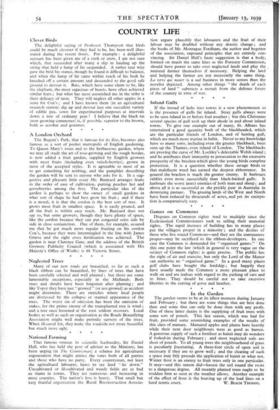* * * * A London Orchard The Regent's Park,
that is famous for its Zoo, becomes also famous as a sort of pocket metropolis of English gardening. To Queen Mary's roses and to the herbaceous garden, where we may all study the art of rose-growing and the rough border, is now added a fruit garden, supplied by English growers with most fruits (including even veitch-berries), grown in most of the accepted styles. It is agreeable to most of us to get something for nothing, and the pamphlet describing the garden will be sent to anyone whO asks for it. In a sug- gestive and pleasant little essay Mr. Bunyard arranges fruits in the order of ease of cultivation, putting peaches last and gooseberries among the first. The particular idea of the garden is perhaps to show the owner of small gardens in what sort of shape he had best grow his fruit ; and if there is a moral, it is that the cordon is the best sort of tree. It grows most fruit in smallest space. It is easily pruned, and all the fruit is within easy reach. Mr. Bunyard does not say so, but some growers, though they have plenty of space, like the cordon because they can put congenial sorts side by side in close conjunction. One of them, for example, assured me that he got much more regular fruiting on his cordon Cox's, because they were intermingled in the line with James Grieve and the right cross fertilisation was achieved. The garden is near Clarence Gate, and the address of the British Growers Publicity Council (which is associated with His Majesty's Office of Works) is 68 Victoria Street.






































 Previous page
Previous page